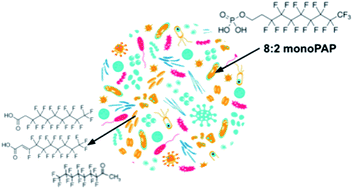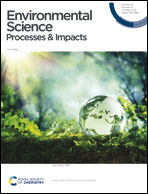The human fecal microbiome contributes to the biotransformation of the PFAS surfactant 8:2 monosubstituted polyfluoroalkyl phosphate ester†
Abstract
Polyfluoroalkyl phosphate esters (PAPs) can be found throughout society due to their numerous commercial applications. However, they also pose an environmental and health concern given their ability to undergo hydrolysis and oxidation to several bioactive and persistent products, including the perfluorocarboxylic acids (PFCAs). The metabolism of PAPs has been shown to occur in mammalian liver and intestine, however metabolism by the gut microbiome has not yet been investigated. In this study, human fecal samples were used to model the microbial population of the colon, to test whether these anaerobic microbes could facilitate 8:2 monosubstituted PAP (monoPAP) transformation. In vitro testing was completed by incubating the fecal samples with 8:2 monoPAP (400–10,000 nM) up to 120 minutes in an anaerobic chamber. Reactions were then terminated and the samples prepared for GC- and LC-MS/MS analysis. Metabolites of interest were the immediate hydrolysis product, the 8:2 fluorotelomer alcohol (FTOH), and 11 additional metabolites previously shown to form from 8:2 FTOH in both oxic and anoxic environments. The kinetics of 8:2 monoPAP transformation by gut microbiota were compared to those in human S9 liver and intestine fractions, both of which have active levels of hydrolyzing and oxidative enzymes that transform 8:2 monoPAP. Transformation rates from 8:2 monoPAP to 8:2 FTOH were highest in liver S9 > intestine S9 > fecal suspensions. The gut microbiome also produced a unique composition of oxidative metabolites, where the following intermediate metabolites were more abundant than terminal PFCAs: 8:2 fluorotelomer unsaturated carboxylic acid (FTUCA) > 8:2 fluorotelomer carboxylic acid (FTCA) > 7:2 Ketone ≈ perfluorohexanoic acid (PFHxA). Hydrolytic and oxidative metabolites contributed up to 30% of the molar balance after microbial 8:2 monoPAP transformation. Together, the results suggest that the gut microbiome can play a notable role in PAP biotransformation.



 Please wait while we load your content...
Please wait while we load your content...